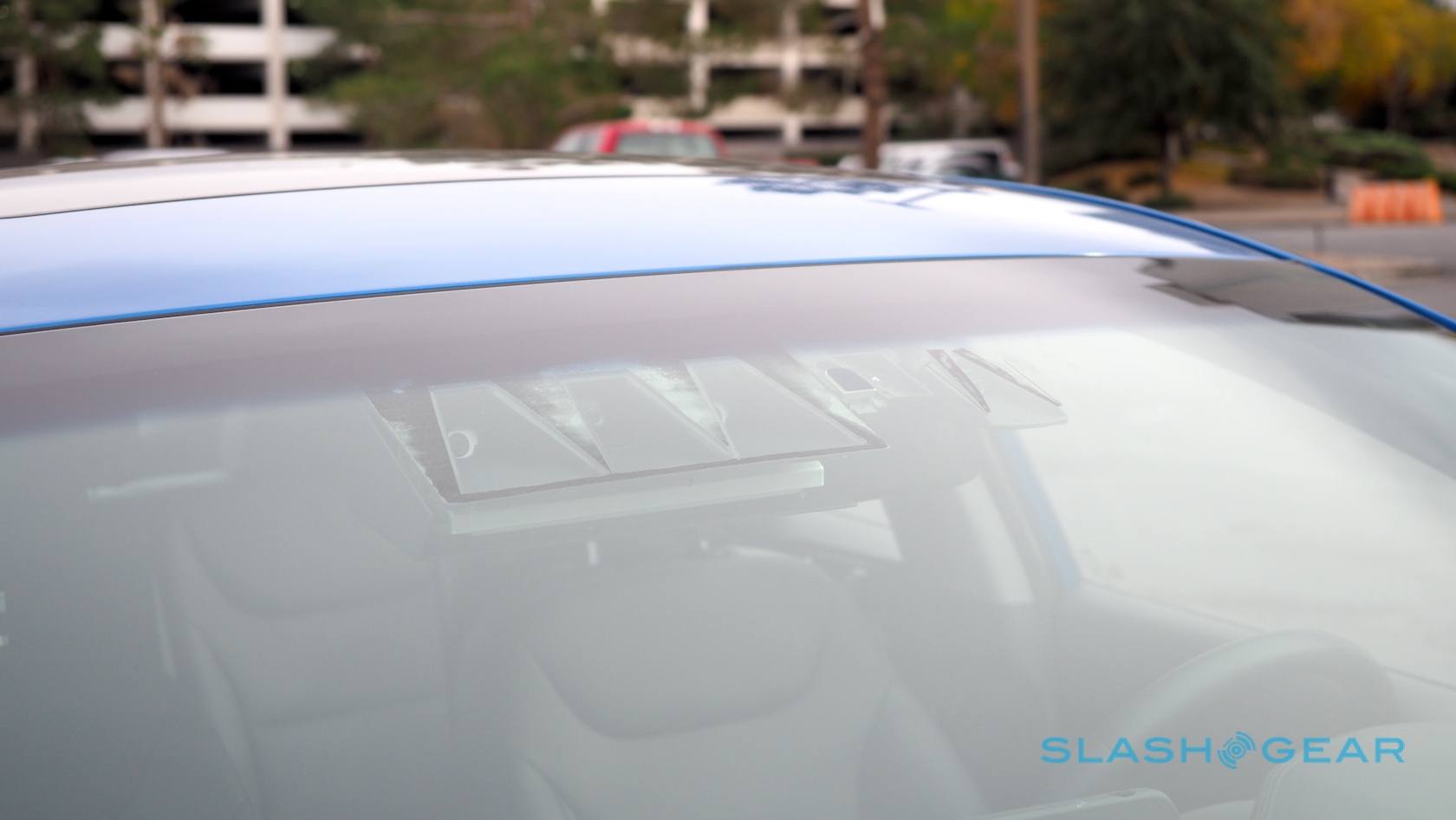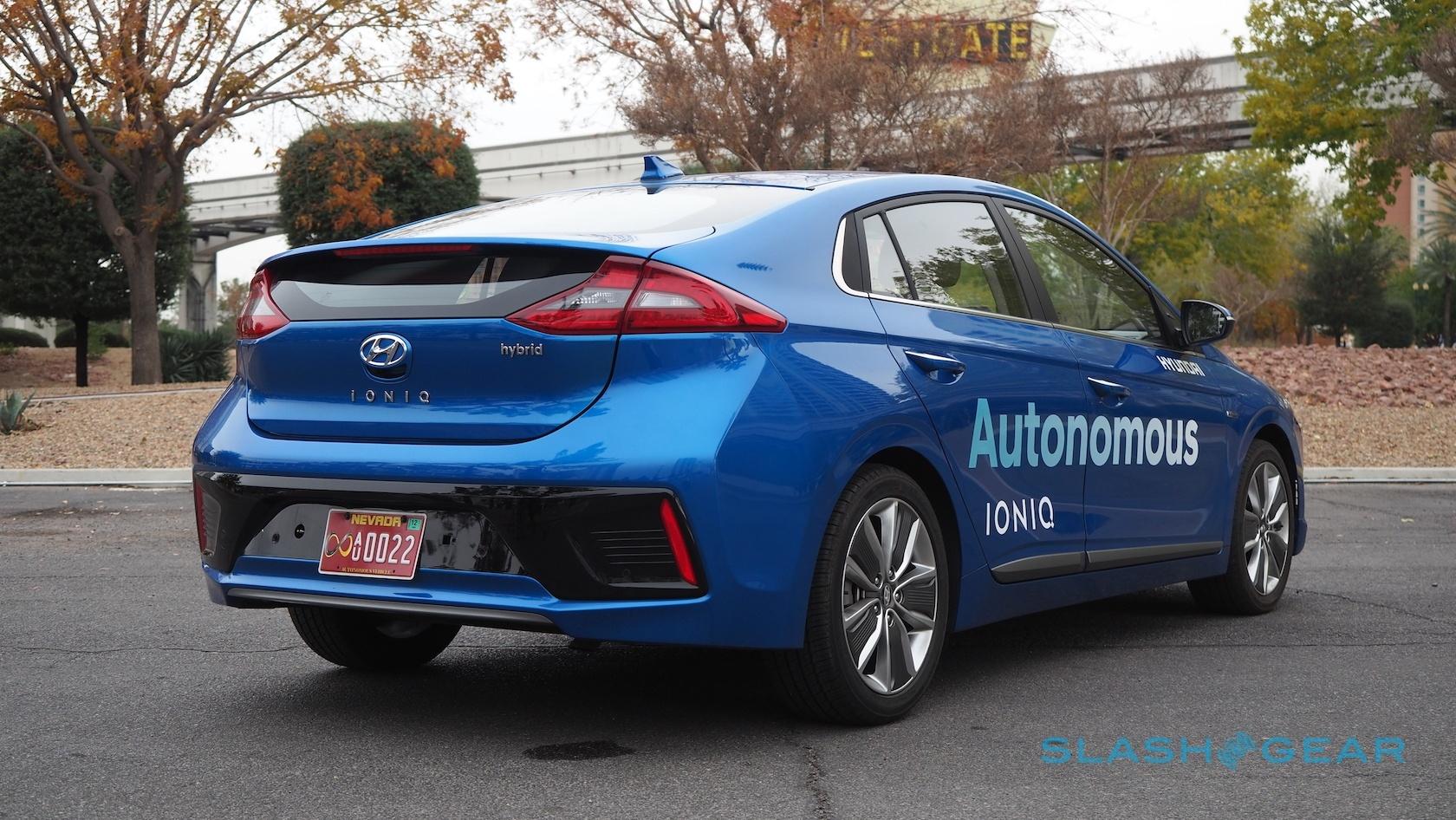Taking Hyundai's Ioniq Autonomous Car For A Las Vegas Test Drive
The Las Vegas Strip does its best to grab your attention, but it's the displays inside Hyundai's Ioniq Autonomous Concept that are holding my gaze as the car drives itself. Nevada's loudest, shiniest city is trying to make a name for itself as more than just gambling and Celine Dion impersonators, aiming to wrest the title of "most tech-friendly" from San Francisco. That means self-driving cars plowing the streets, as automakers like Hyundai attempt to crack the code on the mobility of tomorrow.
It's at Hyundai's invitation that I'm in Vegas, meeting a group from the company's Human Factors & Devices Research Team at the Central Advanced Research Facility in Korea, and taking a spin in their latest autonomous prototype. Though its project might not be as well-known as the self-driving work being undertaken by Google, Uber, and others, Hyundai is no stranger to vehicles that drive themselves. Indeed, a fleet of self-driving shuttles already exists at the Namyang facility.
These, though, are its first prototypes in the US. Hyundai was licensed by the state of Nevada under its autonomous program at the end of 2015, though it only began testing recently. It's a markedly in-house effort, too, for more reasons than simply secrecy and pride.
Rather than develop an all-new autonomous platform, Hyundai opted to retrofit one of its newest vehicles. The Ioniq is, in fact, a number of cars with the same name and broad styling but different powertrains, ranging from a hybrid gas-electric, through plug-in hybrid, to full-electric. It's a lynchpin of the automaker's goal to have fourteen "eco" cars on the road by 2020.
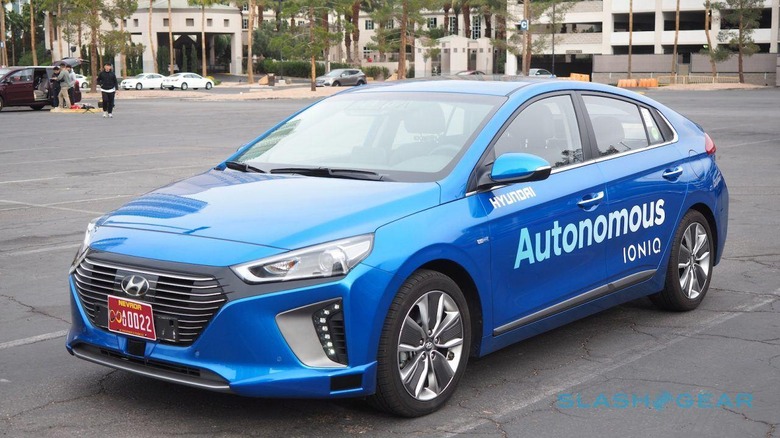
Eventually, that'll consist of five hybrid-electric (HEV), four plug-in hybrid electric (PHEV), four full-electric (EV), and a fuel-cell model that relies on hydrogen. Yet powertrains are only part of Hyundai's scheming. At the same time, it's about the evolving car as a component of overall mobility, whether it's driven by a human or piloted by a computer.
"When we started to develop the Ioniq, our goal wasn't to create a better Prius or a better Leaf," Mark Dipko, director of corporate planning and strategy at Hyundai Motor America, explains. "Although our mobility concepts will start from the car, we need to think beyond cars and trucks. We need to think about mobility in all its forms."
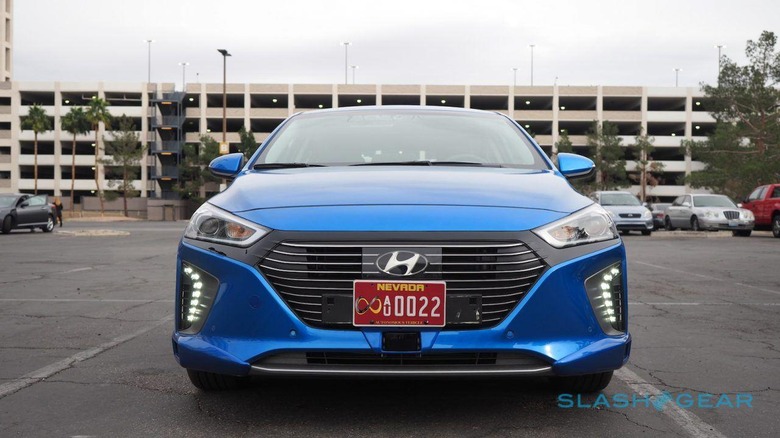
Cars that can drive themselves are a significant part of that mobility equation, yet to look at Hyundai's Nevada-licensed prototypes, you might not realize quite how capable they are. Indeed, while they've been plying the streets of Las Vegas for about a month now, they've only recently gained the "Ioniq Autonomous" badging along the sides. Before that, I'm told, nobody really noticed them.
It was an intentional strategy, Dipko says. "Our Ioniq Autonomous is designed to look like a normal car, not a science project." Partly that's because, for self-driving vehicles to be successful in the mass market, Hyundai recognizes that they need to get past peoples' inherent distrust of the technology. However, just as important is making it practical for mass production.
The result is an autonomous driving system that's far more integrated into the underlying car than many LIDAR-sprouting prototypes from other companies, which bristle with cameras and other sensors. One of the oddities of self-driving research is the number – and nature – of these sensors that each team decides they require. On the one hand, you have something like Tesla's Autopilot, which pushes the limits of camera and radar based sensing; at the other extreme, you have prototypes from Google and others, which are topped with hugely expensive laser rangefinders.

On that grand spectrum, Hyundai falls somewhere in the middle. "We've focused on the mass market," Dipko explains. "We developed this system with existing technology for Advanced Driver Assistance Systems (ADAS), and then fused that with advanced technology for automation. We're developing out own software to keep processing power down, and lower complexity."
Rather than a pricey 360-degree LIDAR on top of the car, Hyundai instead uses three, much cheaper IBO LIDAR sensors positioned at the front and sides of the Ioniq. They're embedded in the lower fascia, too, to the point where you could easily miss them if you weren't looking for them. "We're developing these in a position we feel is acceptable for production," Dipko points out.
Only the front and sides get LIDAR. In tandem with that, Hyundai uses mid- and long-range radar on the front and rear, together with quad-camera array mounted up near the rear-view mirror in the windshield. These overlapping fans of coverage give a 360-degree perspective of the road, but at a fraction of the cost of, say, Google's LIDAR system.

So, the trio of LIDAR sensors track the position, shape, velocity, and heading direct of objects around the front and side of the Ioniq Autonomous Concept, whether they're cars, pedestrians, or something else. Meanwhile, the radar systems spot movement and obstacles front and back. Finally, the camera array serves a variety of purposes: figuring out what radar pings are pedestrians, for instance, as well as tracking lane markings, seeing whether traffic lights are red, yellow, or green, and finally a stereo camera pair to gage distance of other road traffic and buildings.
Blending that sensor data together requires two other things. The first is an onboard computer capable of processing everything in real-time. Hyundai set itself a tougher challenge than many by insisting on the Ioniq Autonomous Concept being as close to production-practical as possible; they couldn't, as Dipko jokes, start with NASA-level technology and then have to figure out how to make it commercially affordable.

"It obviously can't be a twenty thousand dollar option," he points out. System frugality is even more of an issue when you're dealing with an EV, since every watt that goes into the autonomous suite takes away from your overall driving range. Hyundai hasn't picked its production chip vendors yet, but is counting on leapfrog gains in power-to-processing ratios in the intervening years before its self-driving cars need to arrive in dealerships.
The last missing piece is mapping, and it's that more than anything which is keeping the Ioniq Autonomous Concept on its route around Las Vegas – but little further afield. "The map is really the baseline off the area the car is going to be driving in," as Dipko puts it, with far more information than a traditional navigation app or in-car system would get.
Dubbed High Definition Mapping, or HD Map, it adds detail like road grade and curvature to the regular plans, along with the width of each lane and more. For the moment, Hyundai is relying on MnSoft for this, an affiliate company of Hyundai Motor Group which already provides traditional mapping data. "As we move forward to market," Dipko says, "it's possible we'll partner with other vendors."

That's the theory, but what is it like in practice? Hyundai shuttled me (in a resolutely human-driven car) to a nearby parking lot, where two Ioniq Autonomous Concept cars waited. Just as the automaker had suggested, without the badging and the prior warning, you'd probably not guess at first glance that they were high-tech prototypes.
The masked technology continues inside, for the most part. Hyundai has strapped in two LCD displays for those in the rear seats to see what the computer sees. On the left, a feed from the camera array, with traffic signals boxed out when identified and a green flag for when the lights change; on the right, a top-down view of what the LIDAR and radar sensors see around the vehicle, overlaid on top of the HD Map.

There's a third display, and it's the screen most likely to make it to a production car. Mounted above the center console – it's not present in the regular, non-autonomous Ioniq – it shows Hyundai's current vision of just what those inside a self-driving vehicle might need, or want, to see in order to be confident that the car is doing its job.
So, there's the current speed limit, along with red and green indicators confirming what the prototype sees on any traffic lights ahead. An overview of the route is included too, plus a list of upcoming navigation directions. Finally, there's a graphic of the Ioniq Autonomous Concept itself, around which other cars and other traffic appear when they're spotted by the sensors.
It's similar in some ways to what Tesla shows on-screen when in Autopilot mode and, just as is the case there, it's a welcome insight into the "mind" of the car. One of the things that leaves me antsy in piloted or self-driving cars – even if just equipped with traffic-adaptive cruise control – is a sense of uncertainty about whether the systems have are aware of everything I've noticed around me. Without that reassurance, constantly second-guessing the technology can end up more stressful than just driving yourself.

According to Nevada licensing law, Hyundai must have a registered driver behind the wheel, ready to take over at all times should the autonomous system disengage. Once that driver had pulled us out of the parking lot and onto the road, however, a quick stab of a button on the steering wheel saw the computers take over. A sizable "EMERGENCY STOP" button caught my eye in the center console, presumably a last-resort.
Turns out, the Ioniq drives much like a human driver might. Its reactions may be faster than those of a regular person, and it may know what's going on around it at all times and simultaneously, but it's still dealing with fairly unpredictable humans in other vehicles on the road. It wasn't afraid of accelerating to the lights and then slowing eagerly, though it was more cautious than most regular drivers I know when it came to waiting for pedestrians if they were hovering by the curb.
As I've found on other autonomous drives before, it's surprisingly easy to forget that masses of technology have replaced human meat at the wheel. The Ioniq moved smoothly around the preprogrammed route, taking advantage of right-turn-on-red rules when applicable, handling multi-lane roads with zero confusion, and ending up back at the parking lot 10-12 minutes later where Hyundai's driver took over again. Make no mistake, though, this is definitely a living project and a work-in-progress.
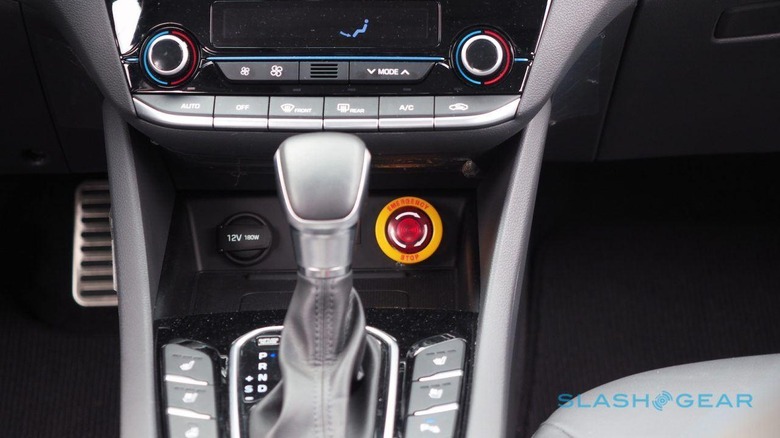
There's nothing quite like real-world testing, Hyundai's engineers explained to me, and the potential for making hundreds of incremental tweaks has been invaluable. That's up to and including discovering an error or inelegant way in how the car reacted to an unforeseen situation on one loop, and changing the programming so quickly that, by the same point on the subsequent loop, the prototype can handle it properly. It's the sort of thing you could never quite do in a lab, and underscores how vital licensed autonomous testing is if such systems are ever to make it to dealerships.
For now, that's still some way off. "The path to autonomy is not a step function," Dipko points out, "it's really a progress over time." All the same, while increasingly capable ADAS systems may give Hyundai owners a taste of what self-driving cars will feel like in practice, there's a huge step between the Ioniq Autonomous Concept I rode in and a vehicle someone could actually buy.

Yes, that's technological on the one hand, but there are also legal and regulatory hurdles to overcome. Unlike Volvo, Hyundai has made no commitment to underwrite accidents deemed the fault of the autonomous technology; even if it did, most states don't have self-driving vehicle licensing in place, never mind cross-state policies. Getting HD Map data for more than a few patches of the country is a vast undertaking.
Hyundai is hoping that an autonomous consortium rises from the current morass, and helps create a path that automakers, legislators, and city planners can all follow together. Nonetheless, it's not sitting idle as it waits for that to happen. "We want to develop our own expertise so that, when it comes time to collaborate, and have these discussions, we can contribute," Dipko insists.
With CES 2017 in just a couple of weeks time, I'd be lying if I said I hadn't considered the convenience of a self-driving car to shuttle me through the tech launch madness. Sadly, for now visitors to Las Vegas are still stuck with taxis, Uber, and traditional rentals if they want to get around. If you're among the congestion, though, keep an eye out for the Ioniq Autonomous Concept as it continues its testing. Hyundai may not be shouting the loudest about its self-driving research, but it could well end up being one of the most affordable systems when it's finally deemed ready for the market.



